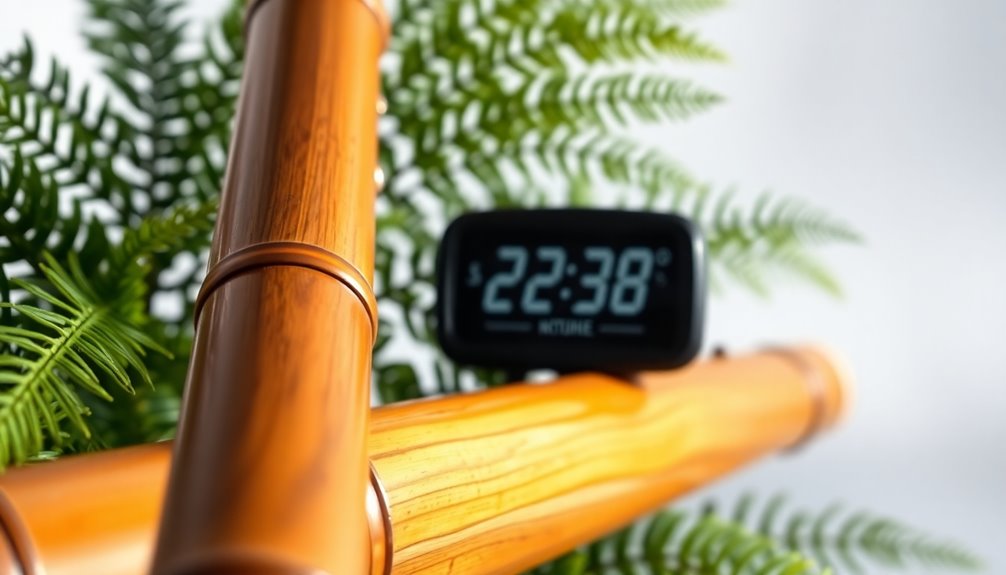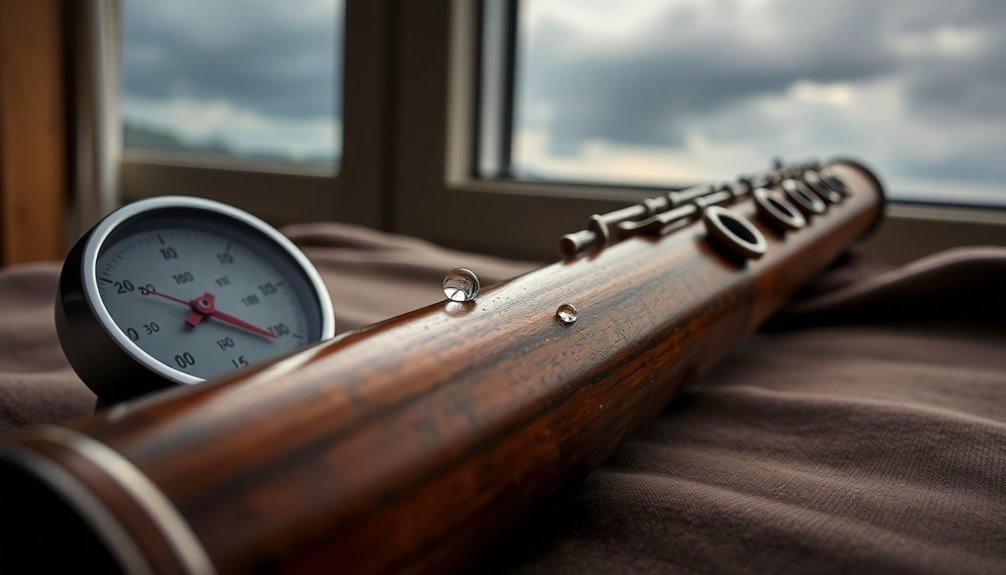To protect your flute from humidity and temperature changes, monitor your environment closely. Keep humidity between 40% and 60% using hygrometers and silica gel packs. For temperature, maintain a range of 65°F to 75°F, avoiding extreme fluctuations. Store your flute in a well-padded case away from heat sources and direct sunlight. Regularly clean your instrument after use to remove moisture and schedule professional checks annually. These steps will enhance your flute's lifespan and performance, guaranteeing it remains in ideal condition. Discover further techniques to guarantee your flute's protection and longevity by exploring additional tips and practices.
Key Takeaways
- Maintain humidity levels between 40% to 60% using hygrometers and humidity control devices like silica gel packs or humidifiers.
- Store your flute in a high-quality, padded case away from heat sources and direct sunlight.
- Regularly clean your flute after each use to prevent moisture buildup that can affect pads and corks.
- Avoid extreme temperature fluctuations and inspect your flute frequently for signs of damage or wear.
- Schedule professional servicing at least once a year to ensure optimal performance and longevity of your instrument.
Understanding Humidity's Effects

While you may not think about it often, humidity plays an essential role in your flute's performance and longevity. Flutes are sensitive instruments, and the moisture balance in the air can considerably impact their condition. High humidity can lead to humidity damage, causing pads to swell and become less effective, which affects your ability to play smoothly.
Conversely, low humidity can dry out the pads and corks, making them brittle and susceptible to cracking.
To maintain your flute in ideal condition, monitor the humidity levels in your environment. Ideally, you want to keep humidity between 40% and 60%. Using a hygrometer can help you track these levels. Regular cleaning with a flute cleaning kit ensures your instrument remains in peak condition, preventing moisture buildup and prolonging its lifespan.
If you live in a region with fluctuating humidity, consider investing in a case with a built-in humidifier or silica gel packs that can help regulate moisture.
Regular maintenance is also vital. After playing, always swab out moisture from your flute to prevent any potential buildup that could exacerbate humidity damage.
Ideal Temperature Ranges

Maintaining your flute within ideal temperature ranges is essential for its performance and durability. Flutes generally thrive in a favorable climate that hovers between 65°F and 75°F (18°C to 24°C).
When temperatures fall below this range, the materials can contract, leading to alignment issues and compromised sound quality. Conversely, excessive heat can cause components like pads and corks to swell or warp, affecting your flute's playability.
To achieve these favorable conditions, be mindful of your environment. Avoid exposing your flute to extreme temperature fluctuations, such as leaving it in a hot car or near heating vents.
Instead, aim for a stable indoor climate, where the temperature remains consistent. If you're practicing outdoors, try to stay away from direct sunlight and cold drafts. Regularly inspect for signs of damage to mitigate any potential issues caused by temperature and humidity changes.
Proper Storage Techniques

Properly storing your flute is essential for preserving its condition and sound quality. By implementing the right storage techniques, you can protect your instrument from humidity and temperature fluctuations. Here are key practices to follow:
- Use high-quality flute cases that fit snugly.
- Choose appropriate storage locations that maintain a stable environment.
- Avoid direct sunlight and extreme temperatures.
First, invest in a durable and well-padded flute case. This not only protects against physical damage but also insulates your flute from rapid temperature changes. Additionally, using a case helps in preventing damage or deterioration caused by environmental factors.
Make certain that the case is kept closed when not in use to minimize exposure to air and humidity.
Next, select a storage location that's away from heat sources or damp areas. Avoid placing your flute near windows or heating vents, as these can cause significant fluctuations in temperature and humidity.
A closet or a dedicated shelf in a climate-controlled room is an ideal choice.
Finally, remember to inspect your flute regularly. Look for any signs of wear or moisture accumulation within the case.
Using Humidity Control Devices

To further safeguard your flute from the damaging effects of humidity, consider incorporating humidity control devices into your storage routine. These devices play a significant role in maintaining an ideal environment for your instrument, ensuring it remains in excellent condition.
There are various device types available, each designed to combat specific humidity issues. For instance, silica gel packs are a popular choice for portable humidity control; they absorb excess moisture, keeping the air dry.
Alternatively, you might opt for electronic hygrometers that not only measure humidity levels but also regulate them by adding or removing moisture as needed.
Another effective option is a humidifier specifically designed for instrument cases. These devices release a steady amount of moisture, preventing the wood from drying out and cracking.
When using these devices, it's important to monitor humidity levels regularly, ideally keeping them between 40-60% for ideal flute care. Regular maintenance using appropriate cleaning techniques is also essential to ensure your flute remains in top shape.
Regular Maintenance Practices

While neglecting regular maintenance can lead to significant issues, establishing a routine care regimen for your flute is crucial for its longevity and performance.
Regular maintenance not only enhances your instrument's playability but also protects it from potential damage caused by humidity and temperature changes.
To keep your flute in top shape, consider the following practices:
- Flute Cleaning: Wipe down your flute after each use with a soft cloth. This removes moisture and oils that can accumulate on the surface.
- Seasonal Checks: At the beginning of each season, inspect your instrument for any signs of wear or damage. Pay special attention to pads, springs, and joints.
- Professional Servicing: Schedule a professional maintenance check at least once a year. A technician can address any hidden issues and guarantee your flute is performing at its best. Additionally, incorporating best practices into your care routine helps sustain flute playability and responsiveness.
Frequently Asked Questions
Can I Use a Regular Humidity Meter for My Flute?
Yes, you can use a regular humidity meter for your flute, but it's best to choose one designed for musical instruments.
Regular humidity meters may not provide the precise readings needed for effective humidity control.
For ideal flute maintenance, monitor humidity levels consistently, aiming for 40-60%.
This guarantees your instrument stays in top shape, preventing damage from fluctuations.
Investing in a specialized meter can enhance your flute care routine considerably.
What Materials Are Best for Flute Cases?
When choosing flute case materials, focus on durability and protective features.
Hard-shell cases, often made from ABS plastic or fiberglass, offer excellent protection against impacts.
Soft cases, crafted from padded nylon or canvas, provide lightweight options with decent protection.
Look for cases with moisture-resistant linings to guard against humidity.
Consider cases with additional compartments for accessories, ensuring you have everything you need while adding a touch of belonging to your musical journey.
How Often Should I Check Humidity Levels?
Imagine you're tuning a vintage radio, trying to catch that perfect station. Just like that, you should check humidity levels regularly for ideal flute maintenance.
Ideally, monitor humidity daily, especially in extreme weather. Use a reliable humidity monitoring device to guarantee levels stay between 40-60%. This keeps your instrument in top shape, preventing damage and guaranteeing a rich sound.
Regular checks foster a sense of belonging in the musical community, keeping your flute happy and healthy.
Does Traveling Affect My Flute's Condition?
Traveling can greatly impact your flute's condition. When you're on the move, you need to take specific travel precautions to guarantee ideal flute maintenance.
Fluctuations in temperature and humidity can lead to damage, so consider using a hard case with humidity control features. Always check the environment before playing, as extreme conditions can affect the pads and mechanisms.
Can I Repair Humidity Damage Myself?
If your flute's been through a bit of a rough patch, you might wonder if you can handle the repairs yourself.
While some humidity repair techniques, like cleaning and adjusting pads, can be tackled at home, it's essential to know your limits.
For effective flute maintenance tips, always consult a professional for any major issues.
Conclusion
In conclusion, protecting your flute from humidity and temperature changes is like shielding a delicate flower from harsh winds. By understanding the effects of humidity, maintaining perfect temperature ranges, and employing proper storage techniques, you can guarantee your instrument remains in prime condition. Incorporating humidity control devices and committing to regular maintenance practices will prolong your flute's lifespan and performance. Remember, a well-cared-for flute sings beautifully, so take the necessary steps to nurture it.






